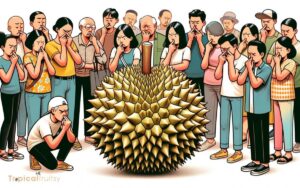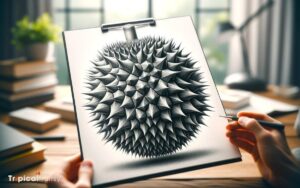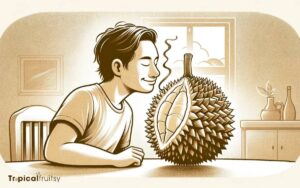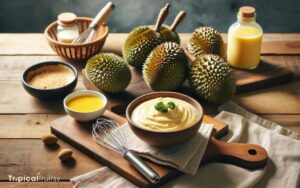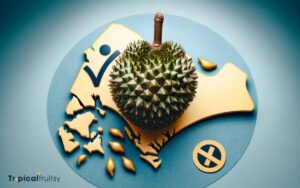How to Care for Durian Flowers? Essential Tips!
Caring for durian flowers involves understanding their unique needs to encourage healthy fruit development.
Key practices include maintaining proper climatic conditions, precise irrigation, soil preparation, fertilization, pest and disease control, pruning, pollination, and post-flowering care.
Durian flowers are delicate and require specific conditions to thrive:
Proper care of durian flowers sets the stage for a bountiful harvest of this exotic and esteemed fruit.
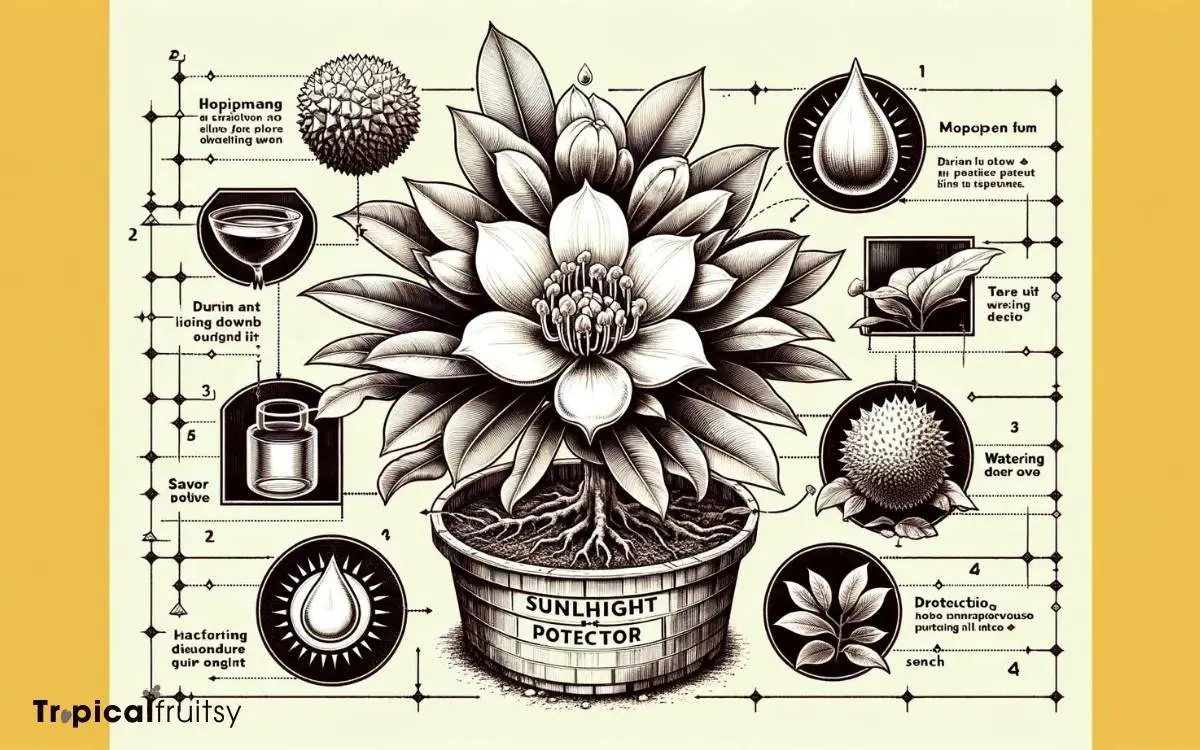
Key Takeaway
Essential Guide for Durian Flower Care
| Care Aspect | Description | Tips/Best Practices |
|---|---|---|
| Climatic Conditions | Warmth and humidity are crucial for durian flowers. | Maintain temperatures around 24-30°C and high humidity. |
| Irrigation | Consistent moisture without waterlogging is key. | Water deeply but infrequently to prevent root rot. |
| Soil Preparation | The soil must be fertile and well-draining. | Enrich soil with compost and ensure proper drainage. |
| Fertilization | Durian flowers require nutrients to form. | Use fertilizers high in potassium and phosphorus. |
| Pest Management | Protect flowers from pests. | Use organic pesticides and monitor regularly. |
| Disease Management | Prevent diseases from affecting the flowers. | Remove affected areas and apply fungicides if needed. |
| Pruning | Prune to maintain tree health and promote flowering. | Prune dead branches and shape the canopy for sunlight exposure. |
| Pollination | Pollination is essential for fruit development. | Attract natural pollinators or hand-pollinate flowers. |
| Harvesting & Post-care | Proper harvesting and care ensure ongoing health. | Harvest with care and continue proper tree maintenance. |
Understanding Durian Flower Biology
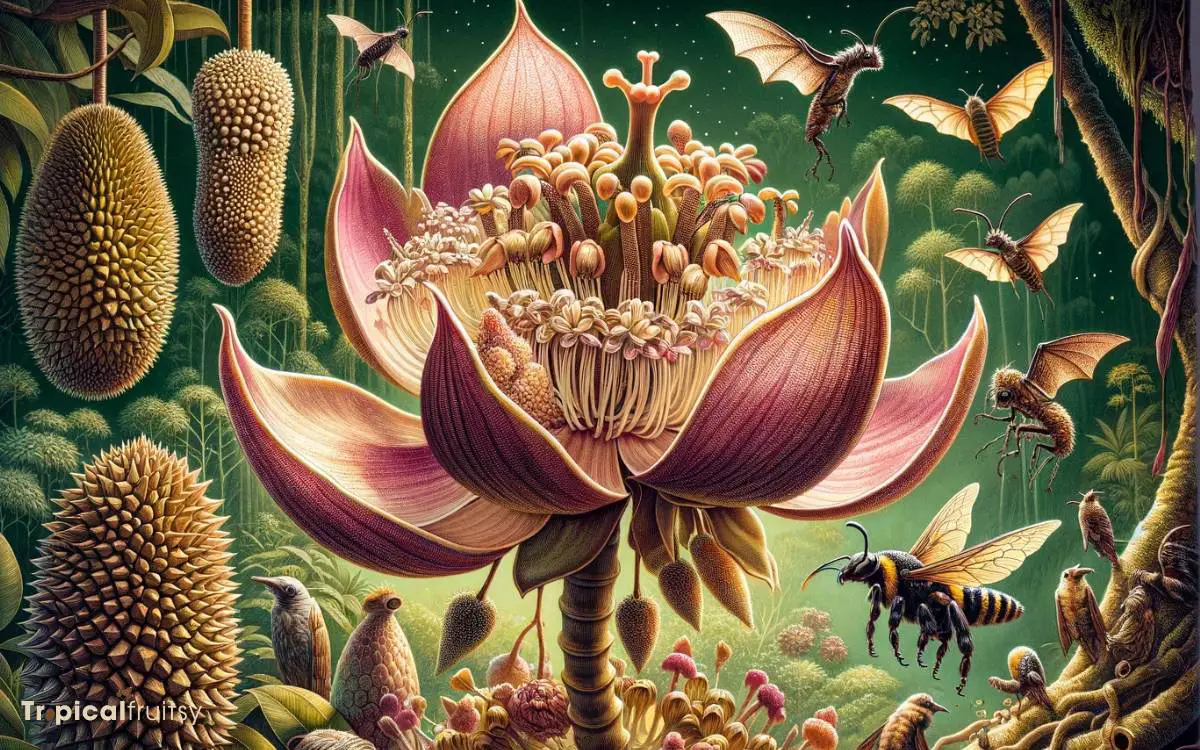
To effectively nurture durian flowers, one must first comprehend their unique biological characteristics.
Durian trees (Durio spp.) typically flower once or twice a year, producing large, petaled blooms that emit a strong odor to attract their nocturnal pollinators, such as bats and certain insects.
These flowers undergo anthesis, the flowering process, which occurs at night when these pollinators are active. This is a critical period for fertilization and subsequent fruit development.
The flowers’ anatomy, with a prominent pistil and stamens, is designed to optimize pollination efficiency. Thorough knowledge of these aspects is paramount for cultivators aiming to maximize fruit yield.
Meticulous attention to the timing and conditions that support pollinator activity can greatly influence successful fertilization.
Ideal Climate for Durian Blooms
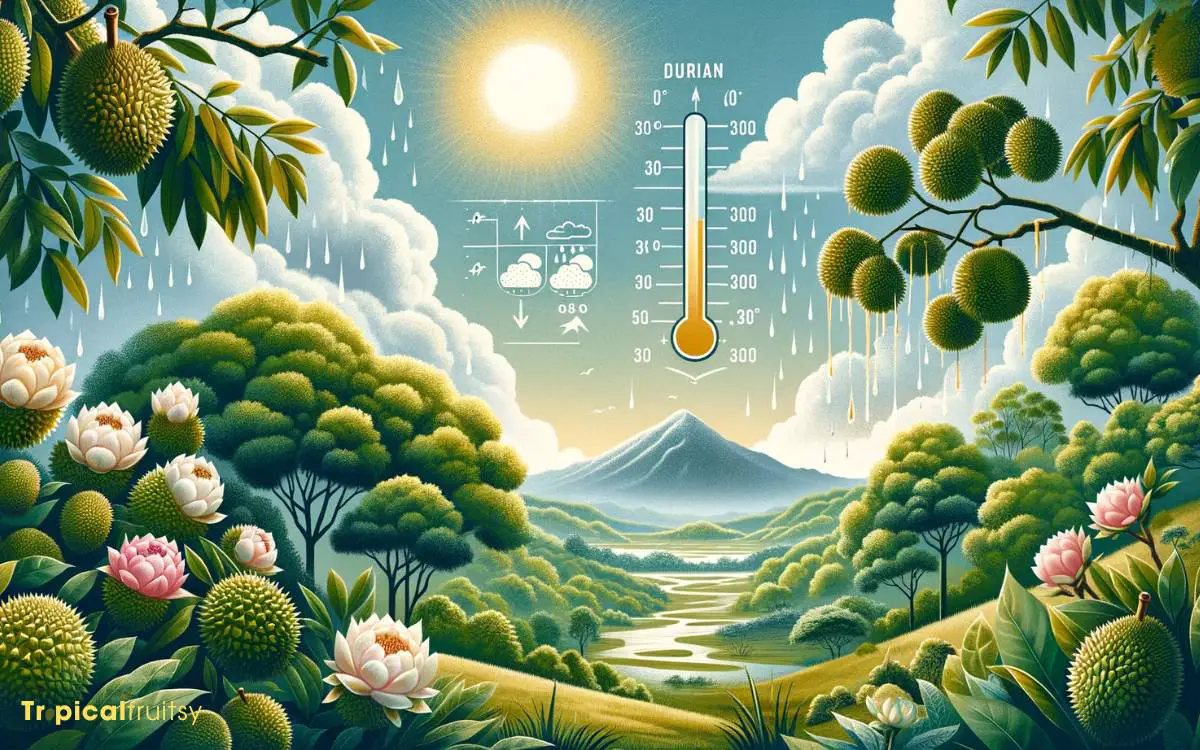
Durian flower care necessitates a keen understanding of the climatic requirements that these blooms need to thrive, including consistent warmth and high humidity.
The ideal climate for durian flowers can be outlined as follows:
- Temperature: Durian flowers flourish in regions where the temperature consistently ranges between 24°C to 30°C (75°F to 86°F), which supports their tropical nature.
- Humidity: A relative humidity of 75% to 80% is crucial for the flowers to maintain their vitality and encourage successful pollination.
- Seasonality: These flowers typically bloom in the dry season, capitalizing on the lower incidence of rain which can otherwise damage the delicate blossoms.
Understanding these climatic parameters is vital for the prosperity of durian trees.
Watering Durian Flowers Properly
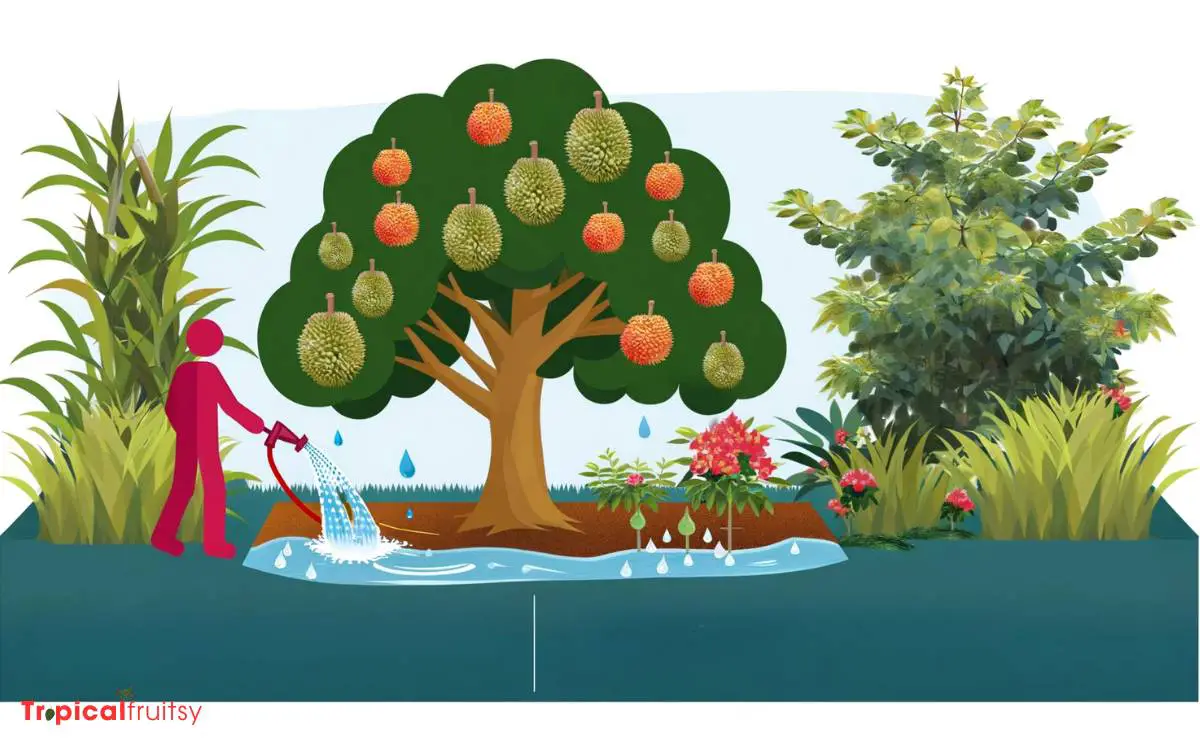
Ensuring adequate hydration for durian flowers is critical, as it influences both the health of the blooms and the subsequent fruit yield. Durian trees require consistent moisture, especially during the flowering stage.
Over-watering can lead to fungal infections and poor fruit set, while under-watering can stress the plant, leading to flower drop.
| Week | Watering Frequency | Additional Notes |
|---|---|---|
| Pre-bloom | 2-3 times per week | Monitor soil moisture |
| Peak bloom | Daily or as needed | Avoid water stress |
| Post-bloom | Adjust as necessary | Reduce frequency |
| Fruit set | Regular, deep water | Encourage root depth |
| Harvest | Taper off | Prepare for dormancy |
An experienced cultivator will recognize the delicate balance required for optimal growth. As each phase presents unique demands, attentiveness to the plant’s signals is paramount.
Soil Requirements and Preparation
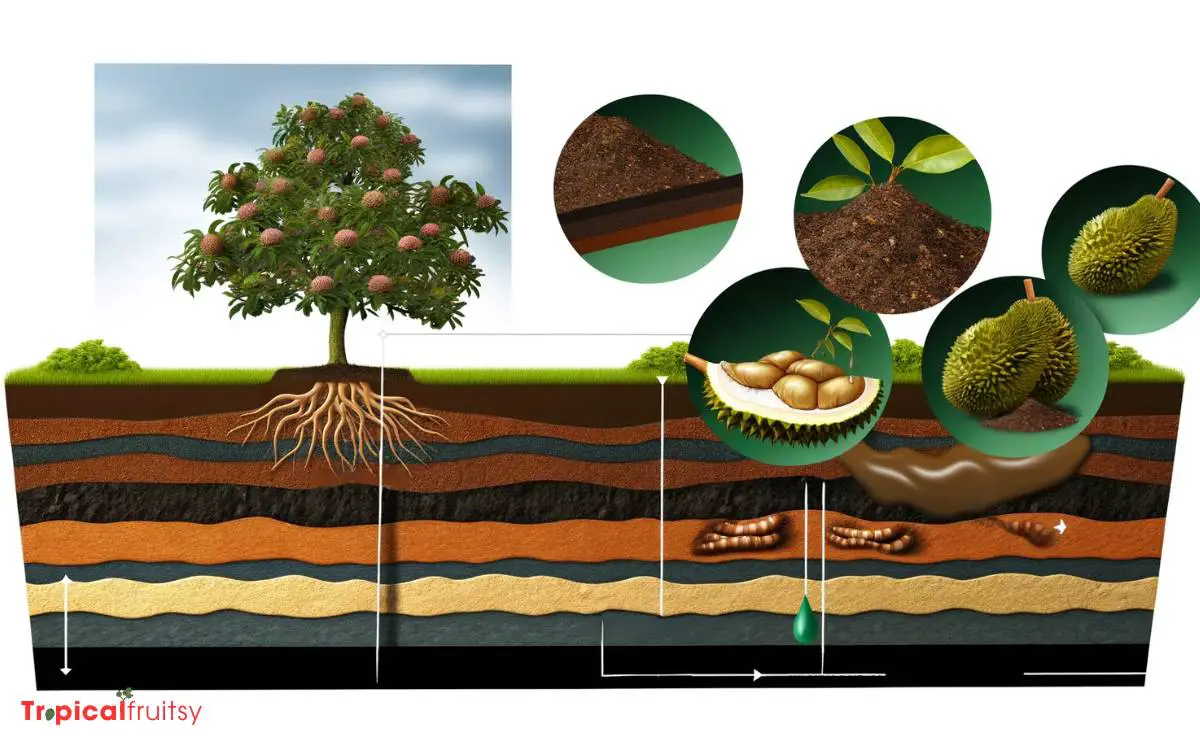
Proper soil preparation and understanding its requirements are fundamental for the health and productivity of durian flowers.
The soil must offer a hospitable environment for these blooms, ensuring they can thrive and develop to their full, fragrant potential.
Here are key aspects to consider:
- Richness: Durian flowers prosper in organically rich soils that provide essential nutrients. Incorporating well-rotted manure or compost will enhance soil fertility and structure.
- Drainage: Superior drainage is crucial to prevent root rot. This can be achieved by amending the soil with sand or perlite if necessary.
- pH Levels: Aim for a slightly acidic to neutral pH range (5.5 to 6.5), which can be managed by routine testing and amendments like sulfur or lime.
Each element combines to create a nurturing bed where durian flowers can bloom majestically, bringing delight to growers and enthusiasts alike.
Fertilizing for Healthy Growth
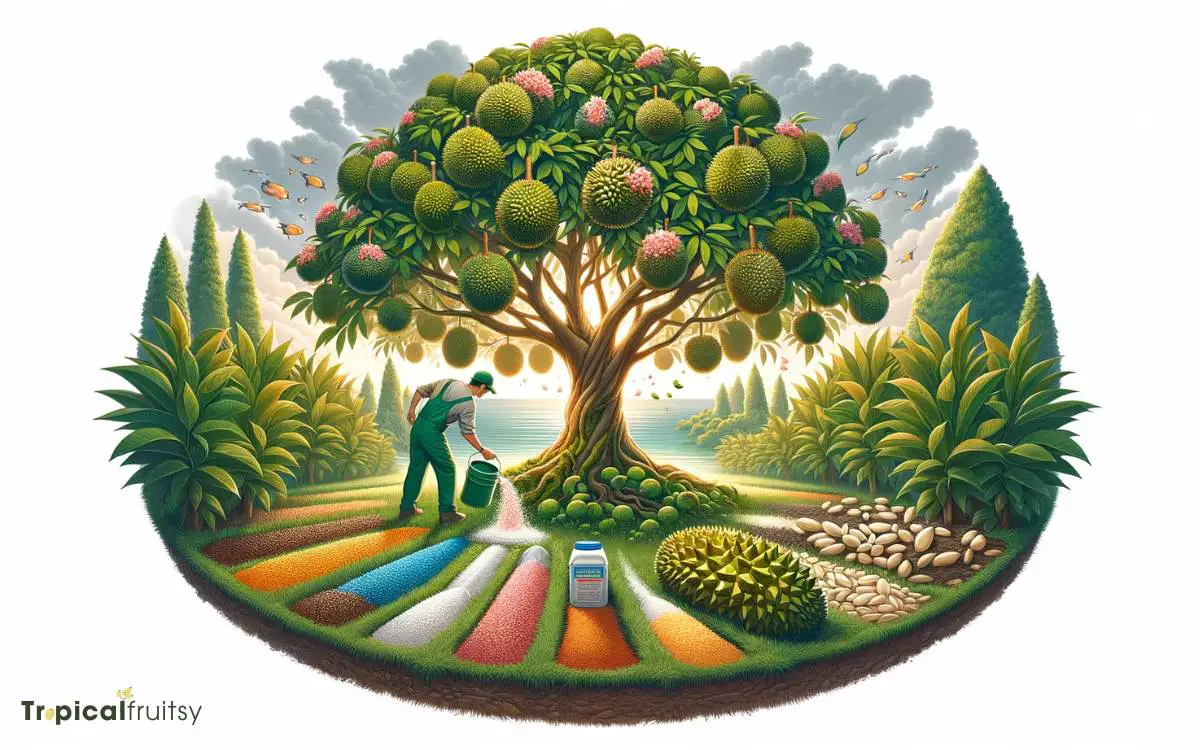
Regularly applying a balanced fertilizer is essential to support the vigorous growth and development of durian flowers.
An appropriate fertilization regimen ensures that the durian trees receive the necessary nutrients to produce robust blooms.
Durian trees typically require a fertilizer high in potassium (K), which aids in flower formation and fruit development. It is also important to provide adequate levels of nitrogen (N) for leaf growth and phosphorus (P) for root development.
The timing of fertilizer application is critical. Apply a balanced N-P-K fertilizer at the onset of the flowering season to promote healthy blossoms.
Additionally, incorporating organic matter such as compost can enhance soil fertility and provide a slow-release source of nutrients.
Careful monitoring of soil nutrient levels through soil testing can guide tailored fertilizer applications to meet the specific needs of the durian trees.
Pest and Disease Management
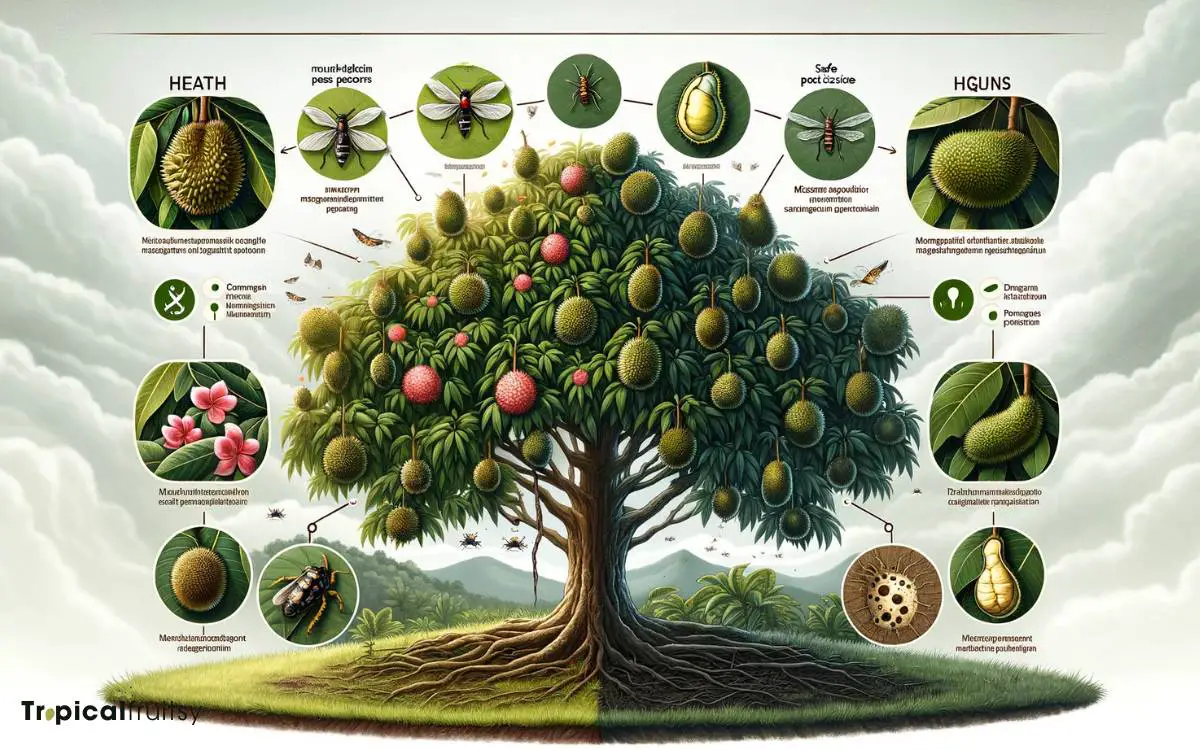
Effective pest and disease management is crucial in maintaining the health of durian flowers, which are vulnerable to a variety of threats.
Accurate identification of common pests, such as thrips, mites, and caterpillars, is essential to implementing targeted control measures.
Simultaneously, adhering to disease prevention tips can mitigate the risk of fungal and bacterial infections that can compromise flower integrity and subsequent fruit development.
Common Pests Identification
In the context of durian flower care, identifying common pests such as thrips, mites, and caterpillars is crucial for maintaining the health and productivity of durian trees.
These pests can inflict significant damage, leading to poor fruit set and yield losses. Close monitoring and accurate identification are the first steps in effective pest management.
Here are common culprits:
- Thrips: These tiny insects can cause flower drop by feeding on the pollen, leading to devastating effects on future harvests.
- Mites: Spider mites create webbing and stippling on leaves, weakening the plant and compromising flower integrity.
- Caterpillars: They chew on the flowers and young fruits, causing direct injury and opening pathways for secondary infections.
Addressing these threats promptly ensures the protection of the delicate durian flowers, securing the forthcoming yield for growers and consumers alike.
Disease Prevention Tips
How can growers mitigate the risk of disease and enhance the resilience of durian flowers against pests and pathogens?
A robust pest and disease management strategy is integral to the health of durian trees.
Prevention is paramount and involves regular monitoring, the application of appropriate fungicides and insecticides, and the adoption of agricultural best practices.
| Prevention Method | Description |
|---|---|
| Regular Monitoring | Early detection of abnormalities in flower development. |
| Fungicides | Use of contact or systemic agents to prevent fungal infections. |
| Insecticides | Targeted application to control pest populations. |
| Cultural Practices | Implement crop rotation and maintain field sanitation. |
Pruning Techniques for Durian Trees
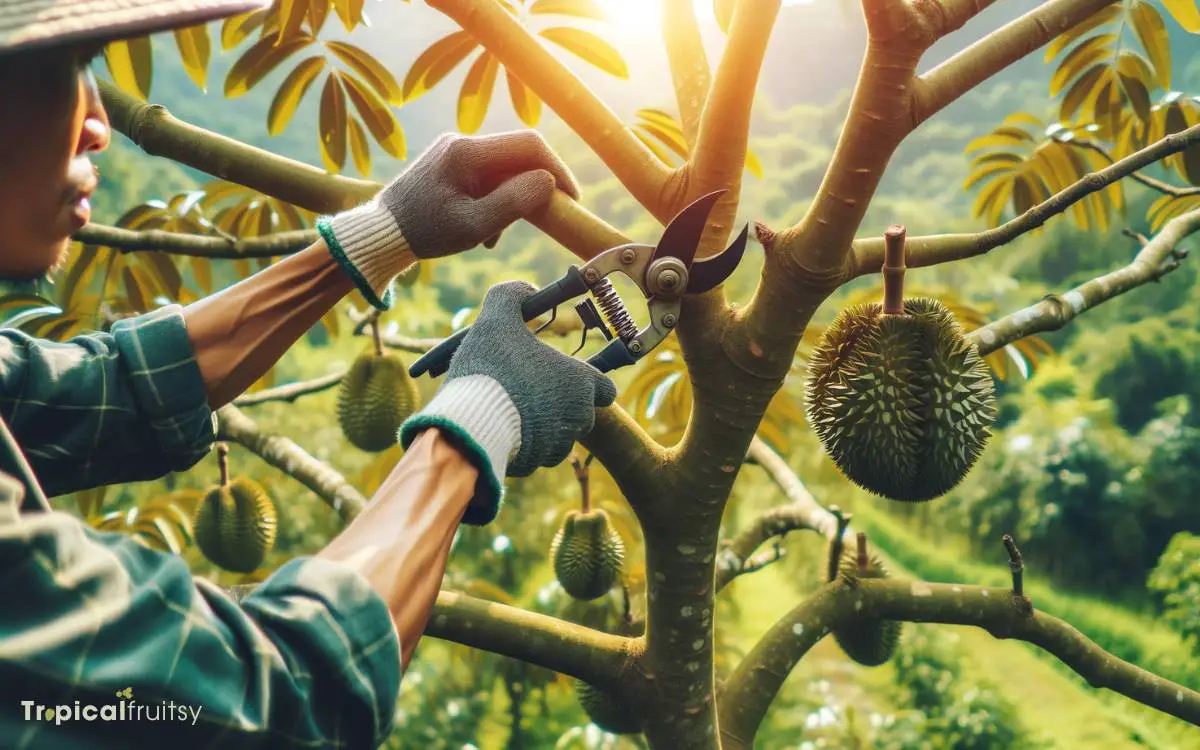
Pruning is a critical horticultural practice for promoting healthy growth and maximizing fruit production in durian trees.
The optimal timing for cutting is crucial; it should coincide with the tree’s dormancy period to minimize stress and enhance recovery.
Selective removal of branches not only shapes the tree for structural integrity but also stimulates the development of flower-bearing branches, essential for a bountiful harvest.
Optimal Cutting Season
To ensure the healthy development of durian flowers, it is essential to perform pruning during the dry season when the trees are less susceptible to stress and disease.
Pruning not only shapes the tree and encourages fruit production but also allows for better air circulation and sunlight penetration, which are vital for healthy growth.
Consider the following steps:
- Remove dead or diseased branches to prevent the spread of pathogens.
- Thin out dense areas to enhance airflow, reducing the risk of fungal infections.
- Trim back overextended branches to focus the tree’s energy on producing robust flowers and fruits.
By adhering to these guidelines, you ensure that your durian trees remain vigorous and productive.
Branches for Flowering
Effective pruning techniques are indispensable for preparing durian trees to produce an abundant and healthy flower set.
Careful selection and removal of branches enhance light penetration and air circulation, critical factors for flower development.
It’s essential to identify the tree’s structural branches and maintain them, while judiciously thinning out secondary branches that compete for nutrients and space.
Experienced cultivators employ targeted cuts to promote spur development—short, stubby branches that are prolific flowering sites.
Strategic pruning involves creating an open canopy that allows sunlight to reach the inner portions of the tree, bolstering overall health and stimulating the growth of flower-bearing spurs.
These techniques require precision and understanding of the durian’s unique growth patterns, ensuring the tree’s energy is directed towards producing a fruitful bloom.
Pollination and Fertilization

How does one ensure successful pollination and fertilization in durian flowers to promote optimal fruit development?
The answer lies in understanding the intricacies of durian flower biology and the role of pollinators.
To achieve this:
- Identify the primary pollinators: Typically, durian flowers are pollinated by bats or certain insects at night. Knowing which creatures aid in your region’s durian pollination can guide your efforts to protect and attract them.
- Facilitate cross-pollination: Since durians are often cross-pollinated, ensure that multiple trees are within proximity to enhance pollination success.
- Provide a conducive environment: Maintain an orchard that supports pollinator health by avoiding pesticides during flowering and offering water sources for bats and insects.
Harvesting and Post-Care Practices
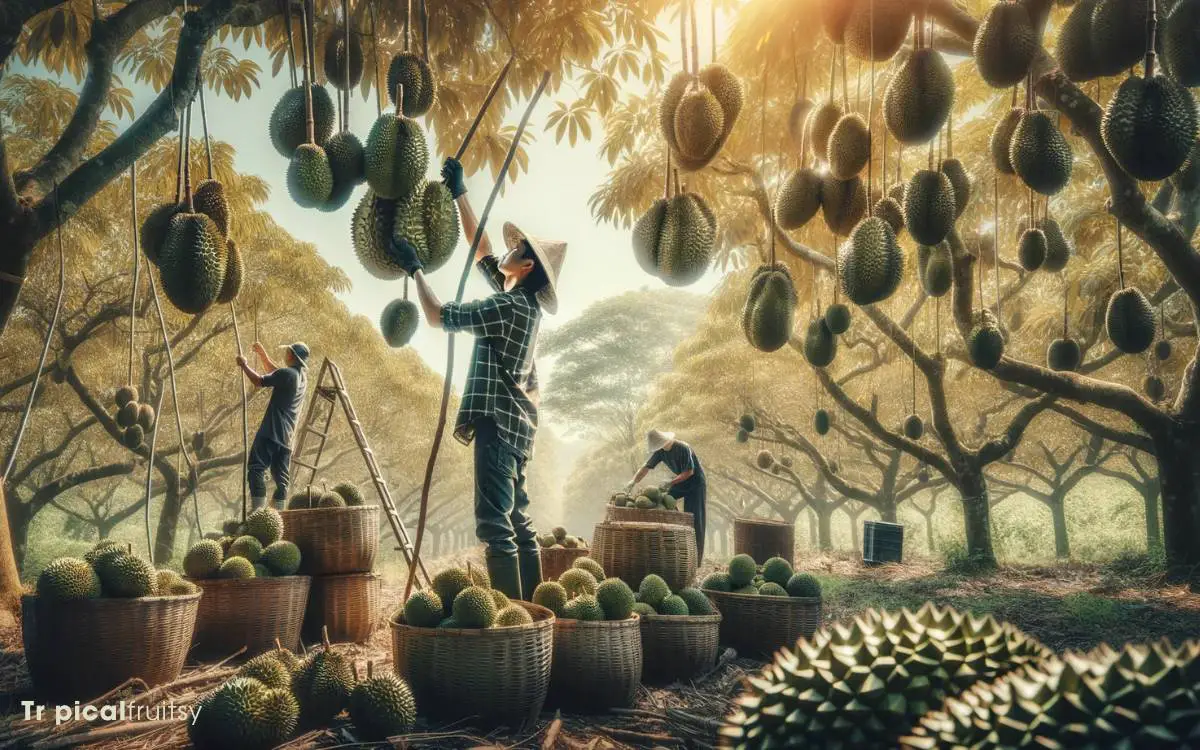
Upon ensuring successful pollination and fertilization, growers must shift their focus to the meticulous process of harvesting durian flowers and implementing post-care practices to maintain the health and productivity of the trees.
The harvesting of durian flowers is a delicate task that requires careful timing to ensure the blossoms are collected when they are most potent, usually at night when their aroma is strongest.
| Stage | Task | Purpose |
|---|---|---|
| Pre-Harvest | Monitoring Flower Health | Ensure optimal ripeness |
| Harvesting | Gentle Handpicking | Minimize damage |
| Post-Harvest | Sanitation & Inspection | Prevent disease spread |
Expertise in these areas is crucial, as it influences both the current and future yields. Post-harvest, rigorous inspection for pests and diseases is essential, followed by sanitation measures to protect the tree and its environment.
Proper care after the harvest can mitigate stress on the durian trees, setting a strong foundation for the next flowering season.
Conclusion
The meticulous cultivation of durian flowers is akin to orchestrating a symphony, where each element from climate to pollination plays a pivotal role in the crescendo of fruit production.
Proper understanding and execution of care practices ensure the trees flourish, yielding bountiful harvests.
Adherence to these guidelines not only enhances the vigor of durian trees but also secures the legacy of this unique and cherished fruit for future generations to savor.


